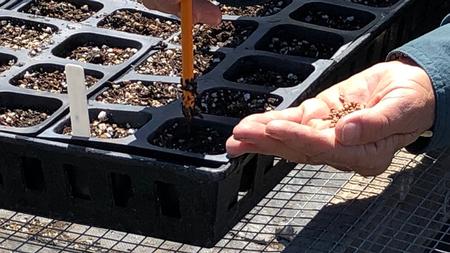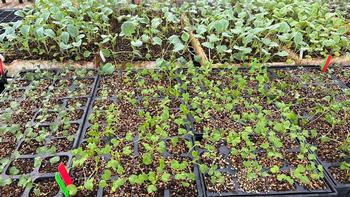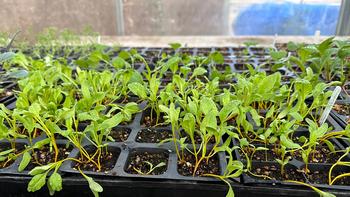News from the Edible Demo Garden
September 2023: Starting With Seeds

Planting starts
In August, seeds for cool season edibles such as fennel, beets, cabbage, kale, radish, and lettuce were planted in seedling trays and placed in the greenhouse. Usually, 2 or 3 seeds are planted in each cell in the tray in case some don’t germinate. A special planting mix, aptly named “breakfast mix”, is used to give these seeds a good start. Breakfast mix is a combination of compost, vermiculite, peat moss, and small amounts of nutrients such as feather meal. A mild, slow-release organic fertilizer is also added. In the controlled light, moisture, and heat in the greenhouse, the seeds can germinate and grow sufficiently to survive the harsher outdoor climate. Home gardeners who don’t have access to a greenhouse can start seeds indoors or in an outdoor cold frame.
When are starts ready to go outside?

Seedlings are fragile and benefit from gradual exposure to outdoor temperatures and sunlight. Bringing the plants outdoors during the day for longer periods of time over a week or more, is a “hardening off” process in preparation for transplanting. New transplants will still need protection from birds, insects, and other hungry garden dwellers. In the Edible Demo Garden, tulle fabric is used to cover newly transplanted starts.
Sowing seeds directly

At the end of July, carrots and chives were sown directly in raised beds in the Edible Demo Garden. Plants that grow vigorously or transplant poorly are better direct seeded. Root crops like carrots are not easily transplanted.
Direct planted seedlings also need protection and consistent moisture. They are vulnerable to pests and competition from weeds and other plants. Plants growing from seeds that have been scatter sown will need to be thinned so that the strongest plants will have room to grow.
The advantages of starting with seed
- Organic gardening - In organic gardens, such as the Edible Demo Garden, starting with organic seeds ensures that the produce grown is free from synthetic contaminants.
- Variety - Probably the best reason for starting with seeds is the variety of plants available. There is a much wider selection of seeds than plant starts obtained in nurseries.
- Cost - Growing from seeds is less expensive than buying starts.
- Timing - Better control of timing is another advantage. Desired plants may not be available in nurseries at the best time needed for planting in the garden.
- Enjoyment – It’s rewarding to nurture seeds and watch them grow into tiny plants.
For more information on starting plants from seeds, visit our webpage on how to plant starts!
